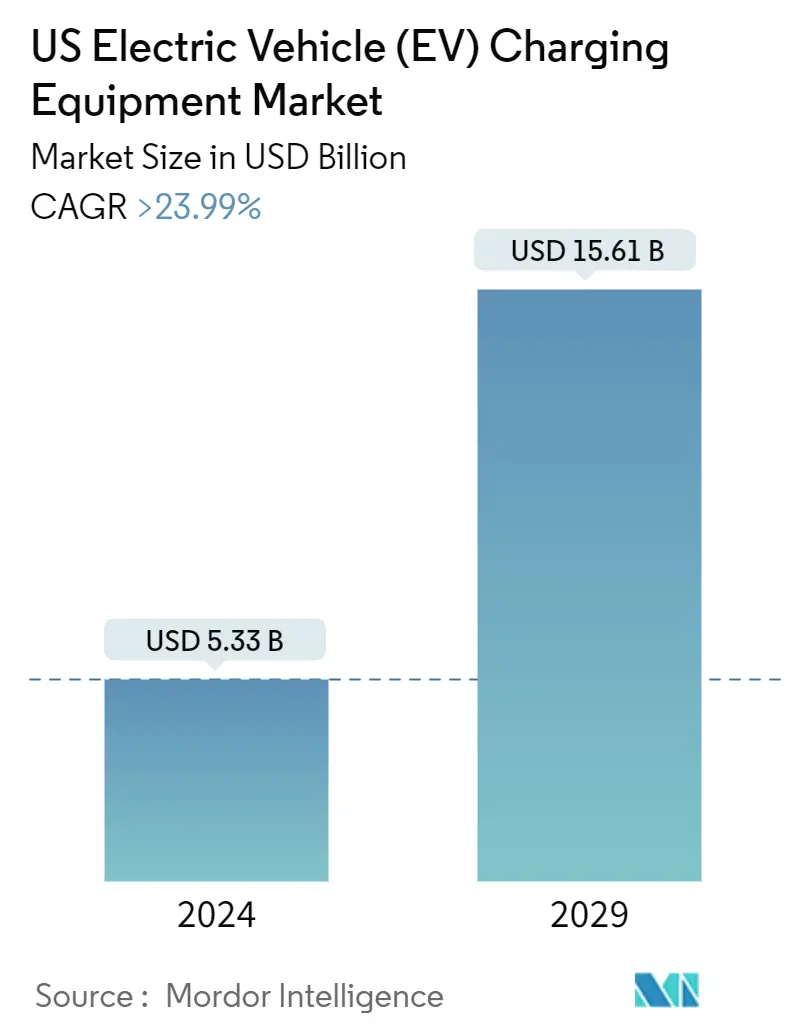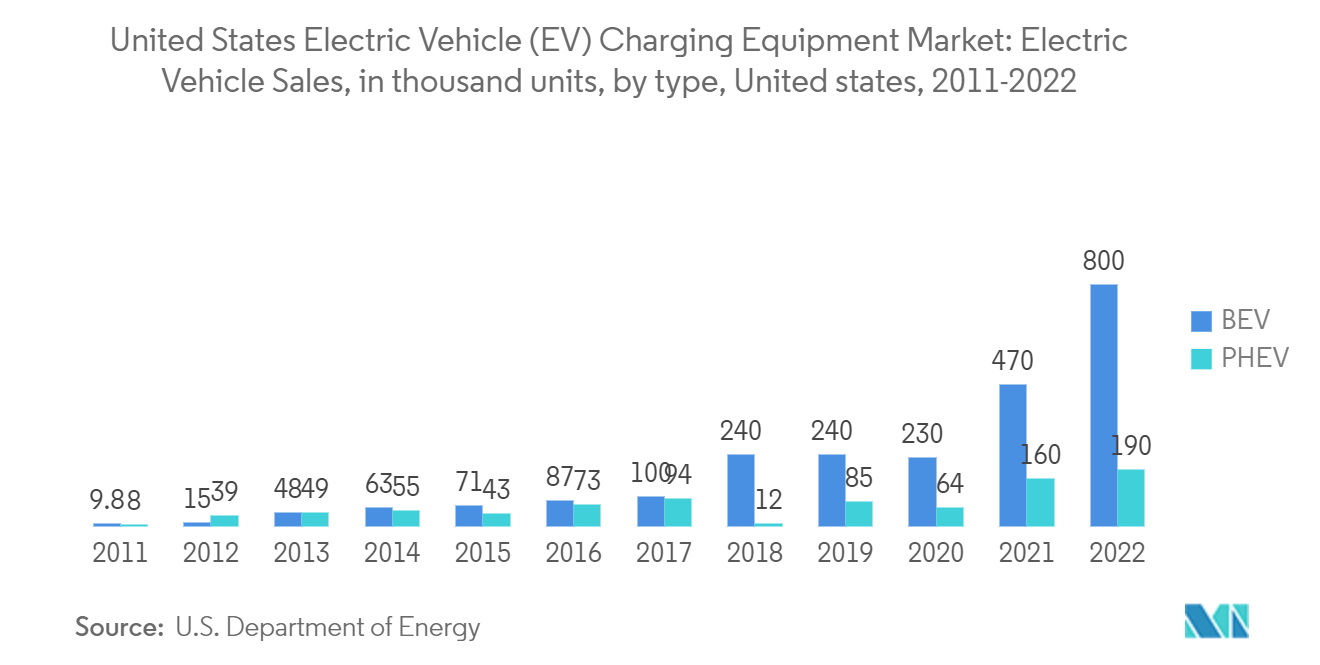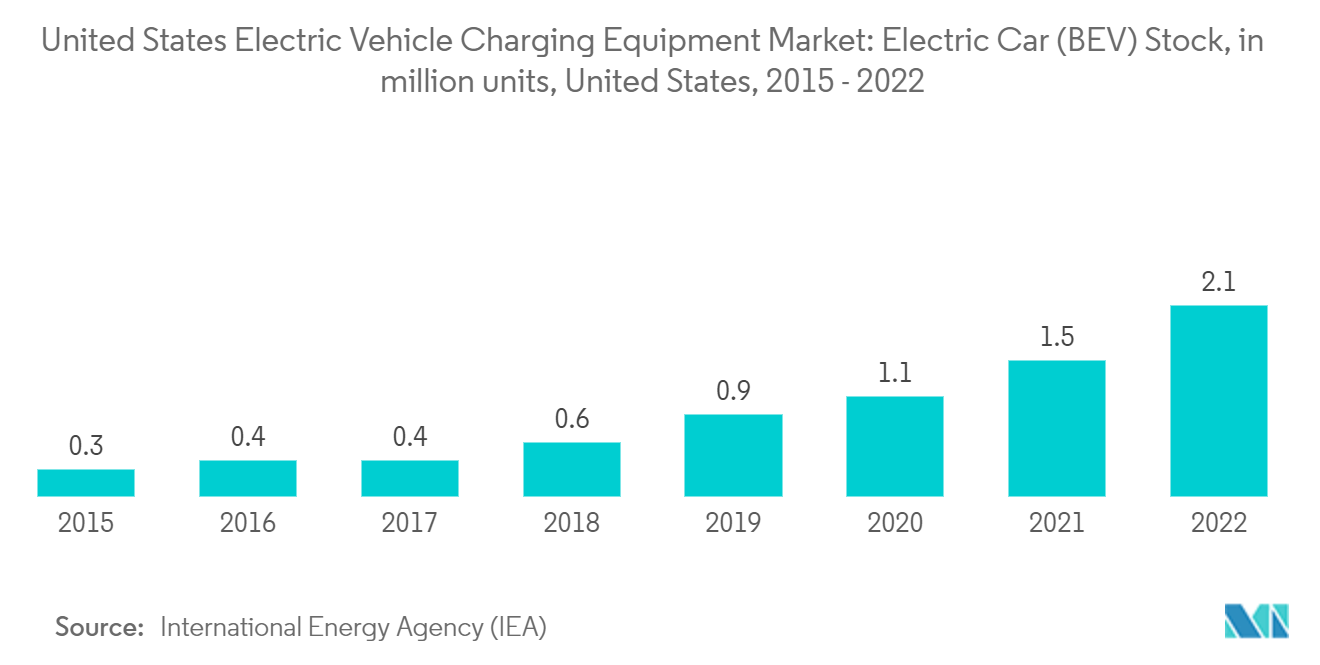US Electric Vehicle (EV) Charging Equipment Market Size

| Study Period | 2019 - 2029 |
| Base Year For Estimation | 2023 |
| Market Size (2024) | USD 5.33 Billion |
| Market Size (2029) | USD 15.61 Billion |
| CAGR (2024 - 2029) | 23.99 % |
| Market Concentration | Medium |
Major Players_Charging_Equipment_Market.webp)
*Disclaimer: Major Players sorted in no particular order |
Need a report that reflects how COVID-19 has impacted this market and its growth?
US Electric Vehicle (EV) Charging Equipment Market Analysis
The US Electric Vehicle Charging Equipment Market size is estimated at USD 5.33 billion in 2024, and is expected to reach USD 15.61 billion by 2029, growing at a CAGR of greater than 23.99% during the forecast period (2024-2029).
- Over the medium term, factors like the growing adoption of electric vehicles in the country and the development of electric vehicle infrastructure are expected to drive the charging equipment market during the forecast period.
- On the other hand, high installation costs associated with setting up charging stations and maintenance costs are expected to hinder the market's growth during the forecast period.
- Nevertheless, increasing investments in EVs and technological advancements in EV charging Equipment are expected to provide significant opportunities for the US electric vehicle (EV) charging equipment market during the forecast period.
US Electric Vehicle (EV) Charging Equipment Market Trends
Increasing Adoption of Electric Vehicles in the Country
- Electric vehicles (EVs) became increasingly popular due to their eco-friendly nature and cost-effective benefits. However, one of the main concerns for EV owners is the availability of charging stations. As the usage of electric vehicles increases, more charging equipment and infrastructures are required to fulfill the need.
- As the adoption of electric vehicles increases, the need for charging devices and relevant infrastructure is expanding. To meet the demand, the government and companies work on installing more charging stations in public areas such as parking lots, malls, and highways. Many electric vehicle owners also install charging stations in their homes for personal use.
- According to the International Energy Agency (IEA), in the United States, electric car sales increased by 55% in 2022 relative to 2021, led by battery electric vehicles (BEV). Sales of BEVs increased by 70%, reaching nearly 800,000 and confirming a second consecutive year of solid growth after the 2019-2020 dip. Sales of PHEVs also grew, albeit by only 15%.
- According to the United States Department of Energy Office of Science, a total of 141,055 plug-in vehicles (100,928 BEVs and 40,127 PHEVs) were sold during December 2023 in the United States, up 42.4% from the sales in December 2022. Also, In December 2023, 117,690 HEVs (31,825 cars and 85,865 LTs) were sold in the United States, up 70.3% from the sales in December 2022. The total stock of electric cars stood at 3 million in 2022, recording more than a 36% increase compared to 2021, accounting for 10% of the global total.
- In February 2023, Under Biden’s Bipartisan Infrastructure Law, the country announced its plan to invest USD 7.5 billion in electric vehicle charging, USD 10 billion in clean transportation, and over USD 7 billion in electric vehicle (EV) battery components, critical minerals, and materials.
- Furthermore, the automakers and battery makers plan to spend over USD 50 billion across 37 dedicated EV battery manufacturing facilities. At total capacity, the facilities could produce 654 GWh in capacity, which is enough to support about 10 million light-duty vehicles annually by 2030 to support their electric vehicle manufacturing and sales. All these investments are likely to boost the adoption of EVs across the United States. It, in turn, is driving the need for EV charging devices and infrastructures over the forecast period.
- Hence, the increasing adoption of electric vehicles (EVs) and investments in the country are expected to continue accelerating the demand for EV charging equipment and hold a promising market over the forecast period.

Battery Electric Vehicles to Dominate the market.
- Battery electric vehicles (BEVs) are also commonly referred to as electric vehicles with an electric motor. The vehicle uses a large traction battery pack to power the electric motor. The EV must be plugged into a wall outlet or charging equipment called electric vehicle supply equipment (EVSE).
- BEVs are fully electric vehicles and typically do not include an internal combustion engine (ICE), fuel tank, or exhaust pipe. They rely only on electricity for propulsion. The vehicle's energy comes from the battery pack, which is recharged from the grid. BEVs are zero-emission vehicles, as they do not generate any harmful tailpipe emissions or air pollution hazards caused by traditional gasoline-powered vehicles.
- The United States is transforming the automotive industry as battery electric vehicles (BEVs) gain momentum and popularity. With technological advancements, government support, and increasing environmental concerns, BEVs emerged as a promising solution to address the challenges of climate change and reduce reliance on fossil fuels.
- In recent years, the adoption of battery-electric vehicles in the United States grew significantly. Improved battery technology, extended driving ranges, and a surge in charging infrastructure helped overcome the initial entry barriers. Automakers like Tesla, Chevrolet, Nissan, and Ford played instrumental roles in popularizing BEVs, offering affordable models that appeal to a broader range of consumers.
- In 2022, the United States registered 990,000 new electric cars, of which about 80% were BEVs, and witnessed a rise of 70% compared to 2021. According to the International Energy Agency (IEA), battery electric vehicle (BEV) sales increased by 40% in the United States relative to 2021.
- According to the United States Department of Energy, the number of publicly available electric vehicle charging points (Level 1, Level 2, and DC Fast) grew from 143,729 in 2022 to 175,547 in 2023. Of the 175,547 charging points in 2023, around 137,795 were slow charging points, and the rest 37,752 were fast charging points. The share of publicly available fast charging points witnessed significant growth in the country in recent years. It is expected to continue the same trend during the forecast period.
- As technology continues to evolve, the future of battery-electric vehicles in the United States looks promising. Automakers, along with the United States government, are investing heavily in research and development to improve battery efficiency, reduce costs, and enhance overall vehicle performance.
- For instance, in Q3 2022, the country invested nearly USD 210 billion in EV and battery manufacturing. The investment is expected to increase, with Tesla including USD 6-8 billion annually in the United States and Germany between 2022 and 2024. Further, automakers and battery makers also planned to spend USD 54 billion across 37 EV battery manufacturing facilities across the country. These facilities are expected to produce 654 gigawatt hours (GWh) of EV battery capacity annually by 2030. Such a scenario is expected with a positive impact on the BEV manufacturing industry.
- Moreover, the emergence of autonomous driving technology and vehicle-to-grid integration further adds to the potential of BEVs to revolutionize the transportation sector. It is thereby driving the demand for charging equipment for battery electric vehicles.

US Electric Vehicle (EV) Charging Equipment Industry Overview
The US electric vehicle (EV) charging equipment market is semi-fragmented. Some of the key players in the market (not in any particular order) include ABB Ltd, Robert Bosch GmbH, Delta Electronics Inc., Siemens AG, and Tesla Inc.
US Electric Vehicle (EV) Charging Equipment Market Leaders
Siemens AG
Tesla Inc.
Robert Bosch GmbH
Delta Electronics Inc.
ABB Ltd
*Disclaimer: Major Players sorted in no particular order
_Charging_Equipment_Market.webp)
US Electric Vehicle (EV) Charging Equipment Market News
- February 2024: United States Connected car service provider Parkopedia collaborated with ChargeHub, the largest North American electric vehicle roaming hub operator. It is to enhance the charging experience for millions of North American electric vehicle drivers. ChargeHub’s 80,000-strong network of charging stations across the United States and Canada will be integrated into Parkopedia’s Payment Platform.
- January 2024: The United States Transportation Department awarded USD 148.8 million to repair or replace nearly 4,500 existing electric vehicle charging ports in 20 different states. The investment would support the EV Chargers that are out of service. The fund is a part of the USD 5 billion National Electric Vehicle Infrastructure (NEVI) program funded by a USD 1 trillion 2021 infrastructure law.
US Electric Vehicle (EV) Charging Equipment Market Report - Table of Contents
1. INTRODUCTION
1.1 Scope of the Study
1.2 Market Definition
1.3 Study Assumptions
2. EXECUTIVE SUMMARY
3. RESEARCH METHODOLOGY
4. MARKET OVERVIEW
4.1 Introduction
4.2 Market Size and Demand Forecast, till 2029
4.3 Recent Trends and Developments
4.4 Government Policies and Regulations
4.5 Market Dynamics
4.5.1 Drivers
4.5.1.1 Increasing Adoption of Electric Vehicles and Related Investments
4.5.1.2 Supportive Government Policies And Initiatives
4.5.2 Restraints
4.5.2.1 High Cost Of Setting Up Ev Charging Stations
4.6 Supply Chain Analysis
4.7 PESTLE Analysis
5. MARKET SEGMENTATION
5.1 Vehicle Type
5.1.1 Battery Electric Vehicle (BEV)
5.1.2 Plug-in Hybrid Electric Vehicle (PHEV)
5.1.3 Hybrid Electric Vehicle (HEV)
5.2 Application
5.2.1 Home Charging
5.2.2 Workplace Charging
5.2.3 Public Charging
5.3 Charging Type
5.3.1 AC Charging (Level 1 and Level 2)
5.3.2 DC Charging
6. COMPETITIVE LANDSCAPE
6.1 Mergers and Acquisitions, Joint Ventures, Collaborations, and Agreements
6.2 Strategies Adopted by Leading Players
6.3 Company Profiles
6.3.1 ABB Ltd.
6.3.2 Robert Bosch GmbH
6.3.3 ChargePoint Inc.
6.3.4 Enphase Energy, Inc.
6.3.5 Delta Electronics Inc.
6.3.6 Powercharge
6.3.7 Siemens AG
6.3.8 Tesla Inc.
6.3.9 KOSTAL Automobil Elektrik GmbH & Co. KG.
6.3.10 Webasto SE
- *List Not Exhaustive
6.4 Market Ranking Analysis
7. MARKET OPPORTUNITIES AND FUTURE TRENDS
7.1 Technological Advancements in the EV Charging Equipment
US Electric Vehicle (EV) Charging Equipment Industry Segmentation
Electric vehicle (EV) charging equipment refers to the infrastructure used to charge electric vehicles. The EV charging equipment plays a crucial role in the widespread adoption of electric vehicles in the United States. The availability of robust EV charging infrastructure is essential for overcoming range anxiety, a primary concern for potential EV buyers. It helps in reducing carbon emissions and improving air quality.
The United States electric vehicle (EV) charging equipment market is segmented into Vehicle Type, Application, and Charging Type. By Vehicle type, the market is segmented into battery electric vehicles (BEV), plug-in hybrid electric vehicles (PHEV), and hybrid electric vehicles (HEV)). By application, the market is segmented into home charging, workplace charging, and public charging. By charging type, the market is segmented into AC charging (level 1 and level 2) and DC charging. The report offers the market size and forecasts for the United States electric vehicle (EV) charging equipment market in revenue (USD) for all the above segments.
| Vehicle Type | |
| Battery Electric Vehicle (BEV) | |
| Plug-in Hybrid Electric Vehicle (PHEV) | |
| Hybrid Electric Vehicle (HEV) |
| Application | |
| Home Charging | |
| Workplace Charging | |
| Public Charging |
| Charging Type | |
| AC Charging (Level 1 and Level 2) | |
| DC Charging |
US Electric Vehicle (EV) Charging Equipment Market Research FAQs
How big is the US Electric Vehicle Charging Equipment Market?
The US Electric Vehicle Charging Equipment Market size is expected to reach USD 5.33 billion in 2024 and grow at a CAGR of 23.99% to reach USD 15.61 billion by 2029.
What is the current US Electric Vehicle Charging Equipment Market size?
In 2024, the US Electric Vehicle Charging Equipment Market size is expected to reach USD 5.33 billion.
Who are the key players in US Electric Vehicle Charging Equipment Market?
Siemens AG, Tesla Inc., Robert Bosch GmbH, Delta Electronics Inc. and ABB Ltd are the major companies operating in the US Electric Vehicle Charging Equipment Market.
What years does this US Electric Vehicle Charging Equipment Market cover, and what was the market size in 2023?
In 2023, the US Electric Vehicle Charging Equipment Market size was estimated at USD 4.05 billion. The report covers the US Electric Vehicle Charging Equipment Market historical market size for years: 2019, 2020, 2021, 2022 and 2023. The report also forecasts the US Electric Vehicle Charging Equipment Market size for years: 2024, 2025, 2026, 2027, 2028 and 2029.
US Electric Vehicle (EV) Charging Equipment Industry Report
Statistics for the 2024 US Electric Vehicle (EV) Charging Equipment market share, size and revenue growth rate, created by Mordor Intelligence™ Industry Reports. US Electric Vehicle (EV) Charging Equipment analysis includes a market forecast outlook to for 2024 to 2029 and historical overview. Get a sample of this industry analysis as a free report PDF download.
